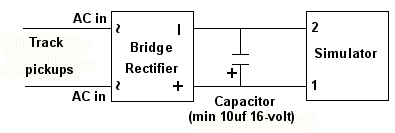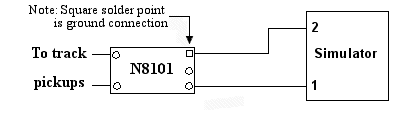Best viewed using:
Internet Explorer
or
Mozilla Firefox
Connecting the N8076/N8076A Fire Truck strobe Simulator
Installing
the N8076N8076A is very straightforward. Because the module has circuitry on both
sides, care must be taken to be sure that the components or wires soldered will
not make contact with any metal object and cause a short
circuit.
Included with the module are two 6” lengths of #32 insulated wire. If
necessary, these can be used for power input wires. If used, we recommend the
red wire be used for the + DC connection. It would be connected to solder point
1
as shown in Fig. 1. This wire could also connect through a switch to the + DC
connection for remote control of the lighting effect. The other (black) wire
should be connected to – DC and to solder point
2.
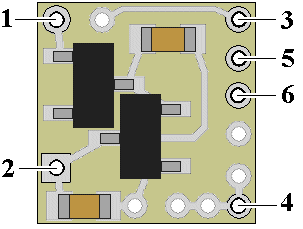
Figure 1
Important note: A low-wattage iron with a pointed tip should be used for connection of wires. Too much heat or solder can easily damage the wires, decoder or module and void the warranty.
Also, all connecting wires should be pre-tinned before soldering them to the module. This will make connection quick and easy and ensure excessive heat is not applied to the solder points.
Track powering (without a decoder connection)
All of our Simulators require a clean DC voltage of known polarity for their power source. Track power is typically provided in one of two forms. DC voltage (analog), or DCC.
Analog track power has been around for more than 75 years. Simply put, a DC voltage is applied to the two tracks with one being +DC and the other, -DC. Increase the voltage and the electric motor in the locomotive spins faster making the train go faster. If the train is required to reverse, track polarity is reversed so the loco's motor turns in reverse. Also, what defines "forward and reverse" is dependent on which way the loco is facing when it's put on the track. Bottom line here is that track polarity is not fixed. Our Simulator needs fixed polarity.
DCC track power is such that to devices requiring plain DC voltage, it looks like AC power. That is because voltage levels on each track go both + and – continuously. The DCC decoders in locomotives “descramble” the track signals and provide correct polarity so their motors can function normally. It is this process that will allow multiple locomotives to go in different directions on the same section of track, at the same time (a feature not available with analog track power). Once again, our Simulator needs fixed polarity and it needs to look like DC voltage.
Due to our Simulator's very small size, there is insufficient space to include additional circuitry and components necessary for proper power conditioning when direct track pickup is to be used. There are two solutions to this problem and both are inexpensive:
Discrete components
The Simulator can be powered from the track with the addition of two readily available components: a bridge rectifier (our N301S or N302S will work just fine). If DCC operation is used, the addition of a filter capacitor (10μf or larger and minimum 16-volt) will be required. Figure 2 below is schematic diagram of the connections required.
Figure 2
This is the least expensive solution, but is has a couple of minor drawbacks. First, the bridge rectifier (and capacitor, if needed) are not mounted on a circuit board so direct solder connection is required and you will need to ensure the pins on the rectifier and leads on the capacitor (depending on the type of capacitor) are organized so that they won't short out against anything. Second, depending on the physical size of the bridge selected (and capacitor, if needed) and the scale you're modeling, hiding these additional components so they're not noticeable can be a bit of a challenge.
N8101 DC Power Source
A more elegant, but very slightly more costly ($3.95) solution would be to use our N8101 DC Power Source. It has all of the components needed, includes a circuit board with solder points, is extremely tiny (1/2 the size of our Simulator), has the lowest possible voltage loss (important for analog operators). Click here for more information on the N8101. Figure 3 below is schematic diagram of the connections required.
Figure 3
Connecting LEDs
When connecting the LEDs, proper polarity must be observed. LEDs are “polarity sensitive” and will not function if connected backwards.
The N8076/N8076A
is configured to connect four (4) 20 ma red LEDs (2 series pairs) between solder
points
3
&
4
and
5
&
4
(this covers Ngineering’s Micro & Nano red LEDs, as well as most red LEDs
available). These LEDs will use the on-board current protection resistor so no
external resistor is necessary. Additionally, the N8076/A
allows for a 5th LED to be connected between solder points
6
&
4
and should be a 20 ma white LED with a device voltage of 3.3-3.6 (this covers
Ngineering’s Micro & Nano white LEDs, as well as most white LEDs available).
Using
wire appropriate for the size of the LEDs and their placement in your project,
connect the LED anodes (A)
and cathodes (C)
together as shown in Figure 4 below. Note that LEDs 1 & 2 are a series pair
(wired anode to cathode) and LEDs 3 & 4 are a second series pair. LED 5’s anode
(A)
is also connected to solder point 4, with its cathode (C)
connected to solder point
6.
Adjusting LED brightness
The N8076/A
is configured with an on-board resistor to provide full, 20mA brightness for all
connected LEDs. While this should appear very prototypical for mid-sized to
larger scale models, for the small scales such as N and Z, the LEDs are likely
to appear over-bright due to their close proximity to each other and the size of
the model. As a result we have included three (3) 1000-ohm (1KΩ)
resistors in the package that can be used to decrease the intensity of the LEDs
to a desired level for the scale of the model.
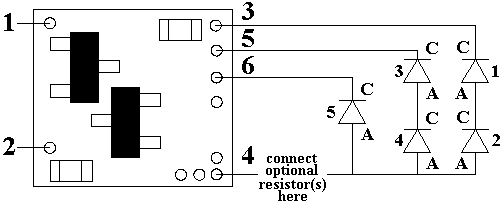
Figure 4
We suggest trying one (1) resistor first to determine if brightness is
sufficiently reduced to your liking. If additional reduction is needed, use
additional resistors in series with the first (connected end-to-end). Figure 4
above shows that these resistors are to be connected between
solder point
4
and the joined
anode
connections of LEDs 2, 4 & 5.
Placement of
the LED on the model
For the best prototypical effect, it is recommended that the LED series pairs
(which will strobe flash together) be placed in the opposite corners of the
fire truck.
For example: If LED 1 is placed in the
left-front
corner of the vehicle, then LED 2 should be placed in the
right-rear.
Then, place LED 3 in the
right-front,
and LED 4 in the
left-rear.
That way, the strobe effect will alternate diagonally across the vehicle giving
a very balanced appearance. See Figure 5 below for a typical example of
placement.
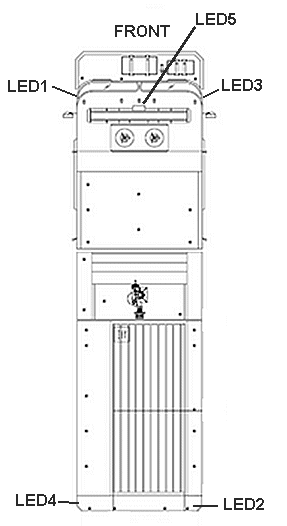
Figure 5
This
completes connection of the N8076/N8076A
module. It is recommended that a thorough re-inspection of all connections and
module placement be performed prior to applying power. We hope you enjoy the
added realism our module provides.
© 20118 Ngineering






















